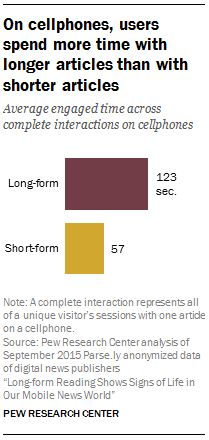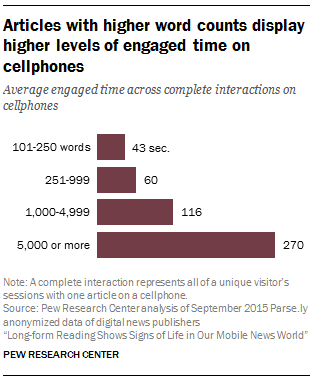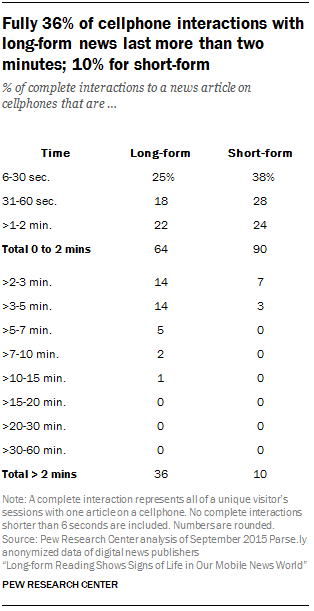
Given the increasing use of mobile devices for online news and the physical challenge of engaging with long-form content on the relatively small screen size of most mobile devices, media analysts have wondered whether there is a future for heftier, more substantial pieces of journalism. One way to test this is to measure the length of time that mobile readers spend with shorter articles compared with longer ones: If the average engaged time for long- and short-form articles is about the same, then one might presume that there is some natural attention limit beyond which a typical newsreader on their cellphone is unwilling to go. If there is a difference, that suggests that readers may be willing to commit more time to a longer piece of work, up to some unknown threshold.
According to the new Pew Research Center study of anonymized data from 30 news websites as measured by the web analytics company Parse.ly, there is evidence that long-form content does garner lengthier attention. Across the 117 million complete cellphone interactions with news articles studied here, longer articles, those that are 1,000 words or more, display higher levels of overall visitor engagement than shorter articles (those between 101 and 999 words). 1 The average engaged time spent with long-form news stories on a cellphone is 123 seconds, about twice that of the 57 seconds for short-form content. 2

What’s more, when we slice the word count more finely, engaged time increases steadily as word count of the articles increases, from a low of 43 seconds for news stories between 101 and 250 words to a high of 270 seconds for stories that are 5,000 words or more. Visitors, in other words, spend nearly three times longer with articles between 1,000 and 4,999 words than with articles that are 250 words or fewer (116 seconds compared with 43 seconds) and spend the most time with articles that are 5,000 words or more – 270 seconds.
Additional evidence of long-form’s more lasting appeal emerges when we look at the portion of users spending various lengths of time with long- and short-form news.

For short-form articles, about four-in-ten complete interactions (38%) are 30 seconds or shorter; 90% are two minutes or shorter, while fewer than 1% last longer than five minutes.
Readers of long-form articles on cellphones tend to connect for a greater amount of time than readers of short-form. Just a quarter of these complete interactions are shorter than 30 seconds, while fully 36% extend beyond two minutes – compared with just 10% of short-form interactions. What’s more, 8% of complete long-form interactions are longer than five minutes, whereas virtually no short-form interactions persist this long.
What this suggests is that on small phone-sized screens, the public does not automatically turn away at a certain point in time – or reject digging into a longer-length news article. Rather, they tend to stay engaged past the point of where a short-form article would end.

One other related finding is that even though there is far more short-form content produced than long-form, visitors access long-form content on their phones at the same rate as they access short-form. Overall, short-form news stories represent 76% of the roughly 75,000 articles studied here (nearly 57,000 articles) and draw 76% of all complete interactions (89.5 million). Long-form articles account for 24% of all articles (about 18,000 articles) and attract 24% of all complete interactions (27.6 million). What this means is that although there are fewer long-form articles, they are visited at roughly the same rate as short-form articles: An average of 1,530 complete interactions per long-form article and 1,576 per short-form. In other words, article for article, long-form content attracts the same number of visitors as short-form content. This does not necessarily mean audiences are asking for more long-form content as there is a strong likelihood that most users are not aware of story length when they click on a link. Still, long-form articles do, whether through shares, bookmarks or other means, find their way to as many initial visitors as short-form.


